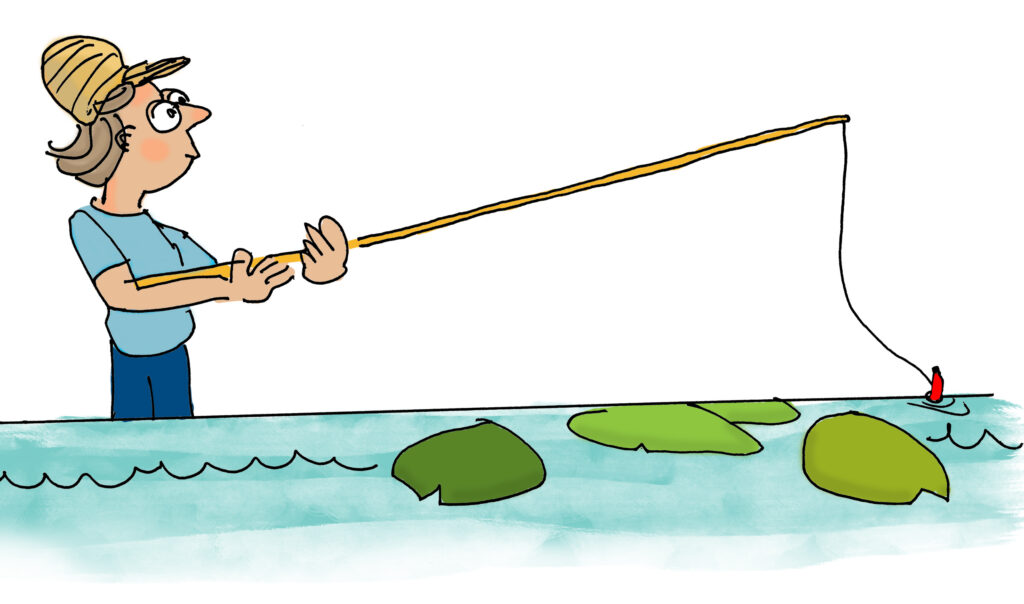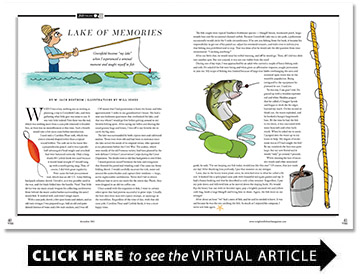Lake of Memories
Greenfield became “my lake” when I experienced a seminal moment and taught myself to fish
BY W. Jack Bostrom

When I was a boy, nothing was as exciting as planning a trip to Greenfield Lake, and then gathering what little gear was mine to use. It was very little indeed! First there was the rod, which was nothing more than a cane pole trimmed in braided line, as there was no monofilament at that time. Such a benefit would take a few more years before introduction.
I used only a Carolina Float cork, which was almost almond shaped rather than a typical round bobber. The cork sat in the water like a perpendicular pencil, and it was typically half submerged if lead weight and attached bait were balanced correctly. Only a long-shank #8 Carlisle hook was used because it would bend straight if I would hang up with a nonforgiving snag. That, of course, I did with great regularity.
Next came the bait procurement tool, which was an old U.S. Army folding backpack infantry shovel. I loved it, as it was possibly used in the war, and the blade folded into the handle. Neat! That little device was my main attack weapon for collecting earthworms from behind the many azalea bushes surrounding the area I would fish. It worked well, and didn’t weigh much.
With a cane pole, shovel, a few spare hooks and sinkers, and an old rusty stringer, I was prepared to go. Add an old and quite-dented thermos of water and a few stale crackers, and I was off.
Off meant that I had permission to leave the house and bike approximately 5 miles to my grandmother’s house. She had a neat one-bedroom apartment that overlooked the lake, and that was where I would go first before getting around to my favorite fishing spots. After saying my hellos and sharing the usual granny hugs and kisses, I was off to my favorite site to catch the big ones.
The lake was surrounded by both cypress trees and cultivated azaleas. Those trees were old and had been in existence since the lake served the needs of its original owner, who operated a rice plantation before the Civil War. The azaleas, which were mostly of the old Formosa variety, had been planted by the now defunct Civilian Conservation Corps during the Great Depression. The shrubs were so old they had grown to over 8 feet.
I would position myself between the lake and evergreens that fronted the paved and winding road. Out came my Army folding shovel. I would carefully excavate the rich, moist soil around the azalea bushes and capture their residents — large, active nightcrawler earthworms. Never did I fail to obtain sufficient bait to serve my needs for the entire day. Plunk, they were dropped in an old tin coffee can.
Once armed with the requisites to fish, I went to certain select spots that had proven successful in prior trips. Usually, the best sites were near old cypress stumps, or openings in the waterlilies. Regardless of the time of day, with that old cane pole, Carolina Float and Carlisle hook, it was a most happy time.
The fish caught were typical Southern freshwater species — bluegill bream, warmouth perch, largemouth bass and the occasional channel catfish. Because Greenfield Lake was a city park, a policeman occasionally would circle the 5-mile circumference. If he saw you fishing from the bank, it became his responsibility to get out of his patrol car, adjust his oversized trousers, and waltz over to inform you that fishing was prohibited and to stop. That was done after he would ask the old question from time immemorial: “Catching anything?”
After our little chat, he would issue his verbal warning, and off he would go. Then, all I did was slide into another spot. But rest assured, it was not one visible from the road!
During one of my trips, I was approached by an adult who carried a couple of fancy fishing rods and reels. He asked if the fish were biting and when given an affirmative response, sought permission to join me. My scope of fishing was limited because of large tree limbs overhanging the area and minimal open water due to the waterlily population. Being intrigued by the equipment he planned to use, I said yes.
To this day, I am glad I did. He geared up with a wooden topwater red and white Heddon popper that he called a Chugger Spook and began to work the far edges beyond my reach. On his second or third cast, the water exploded, and he hooked a hungry largemouth bass. By the time he had the fish to the shore, it was encrusted with water hyacinth and other leafy muck. When he asked me to assist, I jumped into the water up to my knees to help. My degree of excitement was as if I had caught the fish! By my standards the bass was quite large, but my new friend said it would “only” go around 5 pounds.
While cleaning his lure of excessive weeds and other associated gunk, he said, “I’m not keeping any fish today, would you like this one?” Of course, that just made my day! After thanking him profusely, I put that monster on my stringer.
Later, due to the heavy water plant cover, he switched over to what he called a fly rod. It looked like a split/glued cane pole with beautiful red agate guides and tip. It had a funny looking reel that he described as only a line retainer. Regardless, I put my pole down and followed him as he moved down the sloping bank. He would flip the heavy line out with its braided taper, pop a brightly painted red and yellow cork bug, hook a large bluegill and bring him to shore. Again, the fish went on my stringer!
After about an hour “we” had a mess of fish, and he said he needed to leave. It was sad because he was the one catching the fish. As much as I enjoyed his company, I never saw him again.
